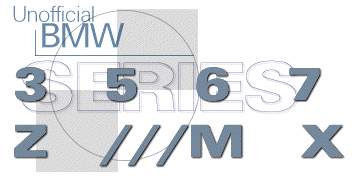|
Ron Stygar Carl Buckland Dale Beuning Forums Help
From digest.v7.n584 Thu Nov 13 15:45:31 1997
Ed Mellinger writes: Ed, Yes, I have some actual damping numbers from Bilstein and I'll attempt some rough estimates on the Boge and Koni shocks. My Bilstein information is better than the other brands because I purchased Bilstein Sports (and Dinan springs) and both Bilstein reps have been extremely helpful. East Coast Rep (CT), Scott MacDonald 203.265-2854 West Coast Rep (CA), Cleve Hardaker 619.453-7723 Shock Damping Numbers, Dyno Speeds Shock damping is the force required to move the shock shaft at a particular (shock piston) speed. Increase the speed and the force increases, so specific damping numbers are always measured at a specific speed.
A complete shock damping curve can be plotted by measuring the
force at various speeds with a shock dyno. Damping force is
measured in newtons (N), kilopond (kp), or pound-force (lbf).
N = 0.101972 kp = 0.224809 lbf. Until reading Paul Haney's shock dyno description in his "Inside Racing Technology" book, I was confused by the different ways of specifying shock speed. Some references talked about speed in terms of shock dyno stroke and rpm, while most used cm/sec or inch/sec. I couldn't correlate the two using mean shock piston speed (i.e. mean speed = 2 x stroke x rpm). Haney's explanation of the convention used for shock dynos confirmed that both methods work out to the same cm/sec or inch/sec speeds. rpm x stroke x pi = speed So for a shock dyno at 100 rpm and 100mm (10cm) stroke: 100 rev min 10cm x 3.14
Typical shock dyno rpm, stroke, and resulting speed:
Stroke Speed Speed
Rpm mm cm/sec inch/sec
---- ------ ------ --------
10 100 5.2 2.1
25 100 13.1 5.2
50 100 26.2 10.3
75 100 39.3 15.5
100 100 52.4 20.6
200 100 104.7 41.1
100 25 13.1 5.2
100 50 26.2 10.3
100 75 39.3 15.5
100 100 52.4 20.6
E28, E24 Bilstein Numbers Bilstein shocks usually come in three valving choices: Comfort = Original ride quality Heavy Duty = Firmer than original Sport = Firmest (shorter shaft for shorter/stiffer springs)
The part numbers work like this: The last four numbers (e.g. P36 0243, for E28 sport front strut) give the model applicability and valving. All the Bilstein reference damping numbers are for 52 cm/sec, a relatively high speed. Obviously one number can't convey what the whole damping curve looks like, but it gives some feel for relative values between the Comfort, Heavy Duty (HD), and Sport valving.
Bilstein E28 5 series 82-88, E24 6 series 83-on
rebound / compression force at 52 cm/sec
Newton pound-force
N lbf (0.2248 x N)
------------ ------------------
Front:
P36 0243 Sport 2900 / 950 652 / 214
P36 0233 HD 2860 / 650 643 / 146
P36 0239 Comfort 1790 / 650 402 / 146
Rear: B46 0607 Sport 1605 / 805 361 / 181 B46 0608 HD 1605 / 805 361 / 181 B46 0610 Comfort 1590 / 770 358 / 173 Notice how close the numbers are between the HD and Sport, while the Comfort front damping is significantly softer. The difference varies between car models. General Bilstein Info, '02 Numbers Bilstein seems to have changed their philosophy through the years. The earlier cars, such as the 'O2, E12 528i, and E21 320i, have much stiffer damping on the Sport shock, while the later E30 and E34 models have the same damping numbers for the Sport and HD. The E28 is somewhere between with little difference except for front compression damping. Taking at look at the 'O2 numbers as an example of an older model: <02> 1600, 2002
Newton pound-force
N lbf (0.2248 x N)
------------ ------------------
Front:
P30 0025 Sport 2150 /1110 483 / 250
P30 0023 HD 1660 / 780 373 / 175
Rear: B46 0118 Sport 2351 / 664 529 / 149 B46 0803 HD 1210 / 575 272 / 129 The 94% increase in rear rebound damping jumps out at me. That may help explain why many experienced BMW owners (probably former '02 Sport users) say to never use Sports on the street. They probably assume that all BMW Bilstein Sports are equally stiff, but the later models are much more reasonable for street use. Comparison to Boge and Koni The original Boge shocks on most E28s should be close to the Bilstein Comfort valving (E28 M5s use front gas charged Boges and rear load-leveling Fichtel and Sachs shocks. The E28 535is uses Bilstein Mtechnic shocks with damping somewhere between the Comfort and HD). Boge turbo gas shocks should be a little stiffer than the standard model. Koni shocks are rebound damping adjustable only, so I assume the compression damping is similar to the Bilstein Sport. The typical starting rebound adjustment is 0.75 turns out of 2.5 turns total, so they probably can be adjusted for stiffer rebound damping than the Bilstein. E28, E24 Shock Summary in order of increasing price
Take your choice. Any of these shocks should be fine. Remember that Boge has been BMW original equipment for years. Bilstein and Koni are the highest price and highest quality. Koni puts the extra cost into making the shock adjustable while Bilstein uses the technically superior monotube design.
Pete Read |

